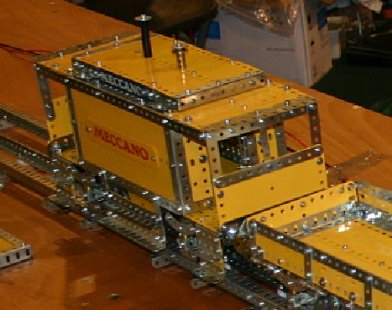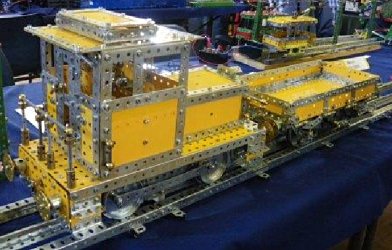Industrial Railway
Written by Brian Elvidge for our January 2011 Newsletter
This model is a 1:16 scale 3½” gauge railway all built from Meccano or compatible parts. There are some non-Meccano items like the wiring, the locomotive’s current collector, and a few other parts.

Industrial railway
Track
This is eight feet in length, formed of pairs of angle girders, with angle girders as sleepers. At each end of the run there is a typical buffer stop, also made of Meccano parts. Offset to one side is a conductor rail (or ‘juice rail’ in railway slang) between the rails, also formed of angle girders, with strengthening strips bolted on. This is insulated from the running rails by insulating spacers specially made for this project by Mr. S. R. Borrill of Skegness, due to the poor availability of the Meccano Elektrikit part and their poor quality construction.
Each track joint is reinforced to ensure the track is rigid and to ensure reliability in operation. A track nominal voltage of 12–20V DC is carried.
Rolling Stock
Due to the availability of parts held, I built only three items of rolling stock: a typical 16 ton mineral wagon of which there were thousands on British Railways, a 12 ton ballast wagon again typical of BR vehicles, and a brake van.
The two wagons have been taken from The Bradley Files edited by Philip Webb in 2010, published by the International Society of Meccanomen and available from MW Mail Order. Both these vehicles were displayed by the late Phil Bradley, President of the Holy Trinity Meccano Club, at various meetings of theirs in the mid 1970s. They have been rebuilt in current yellow/blue and zinc finished parts of the 1970s and 1990s French eras, with slight changes in the construction. Both have operating brakes and either drop sides or doors for off-loading cargoes.
The brake van is based on the L. M. S. 20 ton one immortalised in the Hornby-Dublo range. It is 15½” long with wheel flanges and face plates as wheels, working clasp brakes, foot boards and guard’s accommodation.

Brake van
All the rolling stock can be pulled or pushed by the locomotive described below.
Industrial Diesel Locomotive
This is loosely based upon a Yorkshire Engine Company or Brush Traction design of four wheel diesel electric or hydraulic locomotive used for industrial purposes in steel plants or chemical works and exported world-wide. It is powered by 12–15V DC 540 type electric motor geared to one axle by reduction gears; the other axle is powered by coupling rods, which necessitates accurate quartering of the driving wheels, which are face plates and wheel flanges.

Locomotive
Between the wheels the locomotive picks up the power from a shoe formed by a spring loaded brass strip. This was found to work best. This locomotive will haul or push all the above wagons with ease. The locomotive has detailed brake gear, end handrails, safe refuges for cab entry and shutter access.
Editor’s note: Appropriately, Brian won the Phil Bradley Cup for his model at the Holy Trinity Meccano Club.